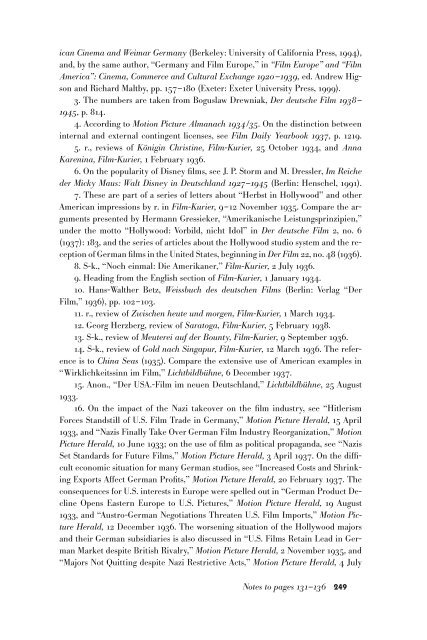Create successful ePaper yourself
Turn your PDF publications into a flip-book with our unique Google optimized e-Paper software.
ican Cinema and Weimar Germany (Berkeley: University of California Press, 1994),<br />
and, by the same author, “Germany and Film Europe,” in “Film Europe” and “Film<br />
America”: Cinema, Commerce and Cultural Exchange 1920–1939, ed. Andrew Higson<br />
and Richard Maltby, pp. 157–180 (Exeter: Exeter University Press, 1999).<br />
3. The numbers are taken from Boguslaw Drewniak, Der deutsche Film 1938–<br />
1945, p. 814.<br />
4. According to Motion Picture Almanach 1934/35. On the distinction between<br />
internal and external contingent licenses, see Film Daily Yearbook 1937, p. 1219.<br />
5. r., reviews of Königin Christine, Film-Kurier, 25 October 1934, and Anna<br />
Karenina, Film-Kurier, 1 February 1936.<br />
6. On the popularity of Disney films, see J. P. Storm and M. Dressler, Im Reiche<br />
der Micky Maus: Walt Disney in Deutschland 1927–1945 (Berlin: Henschel, 1991).<br />
7. These are part of a series of letters about “Herbst in Hollywood” and other<br />
American impressions by r. in Film-Kurier, 9–12 November 1935. Compare the arguments<br />
presented by Hermann Gressieker, “Amerikanische Leistungsprinzipien,”<br />
under the motto “Hollywood: Vorbild, nicht Idol” in Der deutsche Film 2, no. 6<br />
(1937): 183, and the series of articles about the Hollywood studio system and the reception<br />
of German films in the United States, beginning in Der Film 22, no. 48 (1936).<br />
8. S-k., “Noch einmal: Die Amerikaner,” Film-Kurier, 2 July 1936.<br />
9. Heading from the English section of Film-Kurier, 1 January 1934.<br />
10. Hans-Walther Betz, Weissbuch des deutschen Films (Berlin: Verlag “Der<br />
Film,” 1936), pp. 102–103.<br />
11. r., review of Zwischen heute und morgen, Film-Kurier, 1 March 1934.<br />
12. Georg Herzberg, review of Saratoga, Film-Kurier, 5 February 1938.<br />
13. S-k., review of Meuterei auf der Bounty, Film-Kurier, 9 September 1936.<br />
14. S-k., review of Gold nach Singapur, Film-Kurier, 12 March 1936. The reference<br />
is to China Seas (1935). Compare the extensive use of American examples in<br />
“Wirklichkeitssinn im Film,” Lichtbildbühne, 6 December 1937.<br />
15. Anon., “Der USA.-Film im neuen Deutschland,” Lichtbildbühne, 25 August<br />
1933.<br />
16. On the impact of the Nazi takeover on the film industry, see “Hitlerism<br />
Forces Standstill of U.S. Film Trade in Germany,” Motion Picture Herald, 15 April<br />
1933, and “Nazis Finally Take Over German Film Industry Reorganization,” Motion<br />
Picture Herald, 10 June 1933; on the use of film as political propaganda, see “Nazis<br />
Set Standards for Future Films,” Motion Picture Herald, 3 April 1937. On the difficult<br />
economic situation for many German studios, see “Increased Costs and Shrinking<br />
Exports Affect German Profits,” Motion Picture Herald, 20 February 1937. The<br />
consequences for U.S. interests in Europe were spelled out in “German Product Decline<br />
Opens Eastern Europe to U.S. Pictures,” Motion Picture Herald, 19 August<br />
1933, and “Austro-German Negotiations Threaten U.S. Film Imports,” Motion Picture<br />
Herald, 12 December 1936. The worsening situation of the Hollywood majors<br />
and their German subsidiaries is also discussed in “U.S. Films Retain Lead in German<br />
Market despite British Rivalry,” Motion Picture Herald, 2 November 1935, and<br />
“Majors Not Quitting despite Nazi Restrictive Acts,” Motion Picture Herald, 4 July<br />
Notes to pages 131–136 249

















